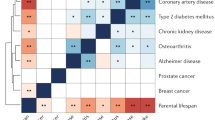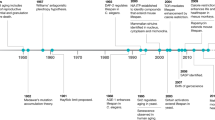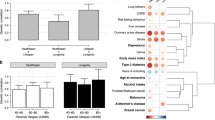Abstract
Rapidly increasing numbers of older people present many countries with growing social and economic challenges. Yet despite the far-reaching implications of ageing, its biological basis remains a topic of much debate. Recent advances in genomics have spurred research on ageing and lifespan in human populations, adding to extensive genetic studies being carried out in model organisms. But how far is ageing controlled by our genes? In this Viewpoint, six experts present their opinions and comment on future directions in ageing research.
This is a preview of subscription content, access via your institution
Access options
Subscribe to this journal
Receive 12 print issues and online access
$189.00 per year
only $15.75 per issue
Buy this article
- Purchase on Springer Link
- Instant access to full article PDF
Prices may be subject to local taxes which are calculated during checkout
Similar content being viewed by others
References
Barzilai, N. & Bartke, A. Biological approaches to mechanistically understand the healthy life span extension achieved by calorie restriction and modulation of hormones. J. Gerontol. A Biol. Sci. Med. Sci. 64, 187–191 (2009).
Finch, C. E. & Ruvkun, G. The genetics of aging. Annu. Rev. Genom. Hum. Genet. 2, 435–462 (2001).
Kenyon, C. J. The genetics of aging. Nature 464, 504–512 (2010).
Gurland, B. J., Page, W. F. & Plassman, B. L. A twin study of the genetic contribution to age-related functional impairment. J. Gerontol. A Biol. Sci. Med. Sci. 59, 859–863 (2004).
Barzilai, N. et al. Genetic studies reveal the role of the endocrine and metabolic systems in aging. J. Clin. Endocrinol. Metab. 95, 4493–4500 (2010).
Kaeberlein, M., McVey, M. & Guarente, L. The SIR2/3/4 complex and SIR2 alone promote longevity in Saccharomyces cerevisiae by two different mechanisms. Genes Dev. 13, 2570–2580 (1999).
Kanfi, Y. et al. The sirtuin SIRT6 regulates lifespan in male mice. Nature 483, 218–221 (2012).
Imai, S., Armstrong, C. M., Kaeberlein, M. & Guarente, L. Transcriptional silencing and longevity protein Sir2 is an NAD-dependent histone deacetylase. Nature 403, 795–800 (2000).
Guarente, L. Sirtuins, aging, and metabolism. Cold Spring Harb. Symp. Quant. Biol. 76, 81–90 (2011).
Christensen, K., Johnson, T. E. & Vaupel, J. W. The quest for genetic determinants of human longevity: challenges and insights. Nature Rev. Genet. 7, 436–448 (2006).
Kirkwood, T. B. L. & Melov, S. On the programmed/non-programmed nature of ageing within the life history. Curr. Biol. 21, R701–R707 (2011).
Kirkwood, T. B. L. & Austad, S. N. Why do we age? Nature 408, 233–238 (2000).
Murphy, C. T. et al. Genes that act downstream of DAF-16 to influence the lifespan of Caenorhabditis elegans. Nature 424, 277–284 (2003).
Anson, R. M., Willcox, B., Austad, S. & Perls, T. Within- and between-species study of extreme longevity—comments, commonalities, and goals. J. Gerontol. A Biol. Sci. Med. Sci. 67, 347–350 (2012).
Soerensen, M. et al. Evidence from case-control & longitudinal studies supports associations of genetic variation in APOE, CETP & IL6 with human longevity. Age 12 Jan 2012 (doi:10.1007/s11357-011-9373-7).
Fontana, L., Partridge, L. & Longo, V. D. Extending healthy life span—from yeast to humans. Science. 328, 321–326 (2010).
Talens, R. P. et al. Epigenetic variation during the adult lifespan: cross-sectional and longitudinal data on monozygotic twin pairs. Aging Cell 23 May 2012 (doi:10.1111/j.1474-9726.2012.00835.x).
Kirkwood, T. B. Understanding the odd science of aging. Cell 120, 437–447 (2005).
Williams, G. C. Pleiotropy, natural selection, and the evolution of senescence. Evolution 11, 398–411 (1957).
Austad, S. N. Is aging programed? Aging Cell 3, 249–251 (2004).
Finch, C. E. Variations in senescence and longevity include the possibility of negligible senescence. J. Gerontol. A Biol. Sci. Med. Sci. 53, B235–B239 (1998).
Rando, T. A. Stem cells, ageing and the quest for immortality. Nature 441, 1080–1086 (2006).
Kirkwood, T. B. et al. What accounts for the wide variation in life span of genetically identical organisms reared in a constant environment? Mech. Ageing Dev. 126, 439–443 (2005).
Rando, T. A. & Chang, H. Y. Aging, rejuvenation, and epigenetic reprogramming: resetting the aging clock. Cell 148, 46–57 (2012).
Herndon, L. A. et al. Stochastic and genetic factors influence tissue-specific decline in ageing C. elegans. Nature 419, 808–814 (2002).
Herskind, A. M. et al. The heritability of human longevity: a population-based study of 2872 Danish twin pairs born 1870–1900. Hum. Genet. 97, 319–323 (1996).
Perls, T. T. et al. Siblings of centenarians live longer. Lancet. 23, 1560 (1998).
Westendorp, R. G. et al. Leiden longevity study group. Nonagenarian siblings and their offspring display lower risk of mortality and morbidity than sporadic nonagenarians: the Leiden longevity study. J. Am. Geriatr. Soc. 57, 1634–1637 (2009).
Wijsman, C. A. et al. Familial longevity is marked by enhanced insulin sensitivity. Aging Cell. 10, 114–121 (2011).
Suh, Y. et al. Functionally-significant insulin-like growth factor-I receptor mutations in centenarian. Proc. Natl Acad. Sci. USA 105, 3438–3442 (2008).
Perls, T. T. et al. Life-long sustained mortality advantage of siblings of centenarians. Proc. Natl Acad. Sci. USA 99, 8442–8447 (2002).
Rajpathak, S. N. et al. Lifestyle factors of people with exceptional longevity. J. Am. Geriatr. Soc. 59, 1509–1512 (2011).
Beekman, M. et al. Genome-wide association study (GWAS)-identified disease risk alleles do not compromise human longevity. Proc. Natl Acad. Sci. USA 107, 18046–18049 (2010).
Barzilai, N. et al. Unique lipoprotein phenoytype and genotype associated with exceptional longevity. JAMA 290, 2030–2040 (2003).
Lucchi, T. et al. I405V polymorphism of the cholesteryl ester transfer protein gene in young and very old individuals. Ann. Ital. Med. Int. 20, 45–50 (2005).
Sanders, A. E. et al. Association of a functional polymorphism in the cholesteryl ester transfer protein (CETP) gene with memory decline and incidence of dementia. JAMA 303, 150–158 (2010).
Howitz, K. T. et al. Small molecule activators of sirtuins extend Saccaharomyces cerevisiae lifespan. Nature 425, 191–196 (2003).
Milne, J. C. et al. Small molecule activators of SIRT1 as therapeutics for the treatment of type 2 diabetes. Nature 450, 712–716 (2007).
Price, N. L. et al. SIRT1 is required for AMPK activation and the beneficial effects of resveratrol on mitochondrial function. Cell. Metab. 15, 675–690 (2012).
Kirkwood, T. B. L. A systematic look at an old problem. Nature 451, 644–647 (2008).
Kirkwood, T. B. L. Systems biology of ageing and longevity. Phil. Trans. R. Soc. B 366, 64–70 (2011).
Passos, J. F. et al. Feedback between p21 and reactive oxygen production is necessary for cell senescence. Mol. Systems Biol. 6, 347 (2010).
Kirkwood, T. B. L., Cordell, H. J. & Finch, C. E. Speed-bumps ahead for the genetics of later-life diseases. Trends Genet. 27, 387–388 (2011).
Harrison, D. E. et al. Rapamycin fed late in life extends lifespan in genetically heterogeneous mice. Nature 460, 392–395 (2009).
Selman, C. et al. Evidence for lifespan extension and delayed age-related biomarkers in insulin receptor substrate 1 null mice. FASEB J. 22, 807–818 (2008).
Selman, C. et al. Ribosomal protein S6 kinase 1 signaling regulates mammalian life span. Science. 326, 140–144 (2009).
Soerensen, M. et al. Human longevity and variation in GH/IGF-1/insulin signaling, DNA damage signaling and repair and pro/antioxidant pathway genes: cross sectional and longitudinal studies. Exp. Gerontol. 47, 379–387 (2012).
Murphy, J. C. et al. Preferential reductions in intermuscular and visceral adipose tissue with exercise-induced weight loss compared with calorie restriction. J. Appl. Physiol. 112, 79–85 (2012).
Martin, G. M. The biology of aging: 1985–2010 and beyond. FASEB J. 25, 3756–3762 (2011).
Remolina, S. C. & Hughes, K. A. Evolution and mechanisms of long life and high fertility in queen honey bees. Age 30, 177–185 (2008).
Friedman, D. B. & Johnson, T. E. A mutation in the age-1 gene in Caenorhabditis elegans lengthens life and reduces hermaphrodite fertility. Genetics 118, 75–86 (1988).
Kenyon, C., Chang, J., Gensch, E., Rudner, A. & Tabtiang, R. A. C. elegans mutant that lives twice as long as wild type. Nature 366, 461–464 (1993).
Conboy, I. M. et al. Rejuvenation of aged progenitor cells by exposure to a young systemic environment. Nature 433, 760–764 (2005).
Willcox, B. J. et al. FOXO3A genotype is strongly associated with human longevity. Proc. Natl Acad. Sci. USA 105, 13987–13992 (2008).
Deelen, J. et al. Genome-wide association study identifies a single major locus contributing to survival into old age; the APOE locus revisited. Aging Cell. 10, 686–698 (2011).
Skytthe, A. et al. Design, recruitment, logistics, and data management of the GEHA (Genetics of Healthy Ageing) project. Exp. Gerontol. 46, 934–945 (2011).
Bekris, L. M., Lutz, F. & Yu, C. E. Functional analysis of APOE locus genetic variation implicates regional enhancers in the regulation of both TOMM40 and APOE. Hum. Genet. 57, 18–25 (2012).
Yang J. et al. Genome partitioning of genetic variation for complex traits using common SNPs. Nature Genet. 43, 519–525 (2011).
Stahl, E. A. et al. Bayesian inference analyses of the polygenic architecture of rheumatoid arthritis. Nature Genet. 44, 483–489 (2012).
Deelen, J. et al. Gene set analysis of GWAS data for human longevity highlights the relevance of the insulin/IGF-1 signaling and telomere maintenance pathways. Age 24 Nov 2011 (doi:10.1007/s11357-011-934020113).
Beekman, M. et al. Genome-wide association study (GWAS)-identified disease risk alleles do not compromise human longevity. Proc. Natl Acad. Sci. USA 107, 18046–18049 (2011).
Passtoors, W. M. et al. Transcriptional profiling of human familial longevity indicates a role for ASF1A and IL7R. PLoS ONE 7, e27759 (2012).
Author information
Authors and Affiliations
Corresponding authors
Ethics declarations
Competing interests
Leonard Guarente is Chair of the scientific advisory board of Sirtris Pharmaceuticals. Nir Barzilai, Thomas B. L. Kirkwood, Linda Partridge, Thomas A. Rando and P. Eline Slagboom declare no competing financial interests.
Rights and permissions
About this article
Cite this article
Barzilai, N., Guarente, L., Kirkwood, T. et al. The place of genetics in ageing research. Nat Rev Genet 13, 589–594 (2012). https://doi.org/10.1038/nrg3290
Published:
Issue Date:
DOI: https://doi.org/10.1038/nrg3290
This article is cited by
-
Negative reciprocal regulation between Sirt1 and Per2 modulates the circadian clock and aging
Scientific Reports (2016)
-
Health status and 6 years survival of 552 90+ Italian sib-ships recruited within the EU Project GEHA (GEnetics of Healthy Ageing)
AGE (2014)
-
Parallel evolution of senescence in annual fishes in response to extrinsic mortality
BMC Evolutionary Biology (2013)



